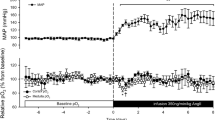Summary
The effect of renal ischemia of 15 s to 60 min duration on the tissue levels of adenosine, inosine and hypoxanthine was investigated in Sprague Dawley rats. A sharp increase in the tissue levels of adenosine from 5.13±0.56 to 31.3±2.96 nmol/g wet weight after 1 min of ischemia was found. The tissue levels of inosine and hypoxanthine in the controls were 3.62±0.51 and 3.19±0.76 nmol/g wet weight, respectively. Maximal levels of adenosine (38.1±6.3 nmol/g wet weight) were reached after 10 min of ischemia. The hypoxanthine levels rose steadily up to 922±183 nmol/g wet weight after 60 min of ischemia. Recirculation of 15 min after 60 min ischemia resulted in a fall of adenosine and inosine levels to values comparable to controls, whereas hypoxanthine was elevated above control values. In a second experimental series with tracing of renal blood flow (RBF) by a means of an electromagnetic flow meter a transient marked reduction of RBF after occlusion of the renal artery for 30 s was observed. The 3-fold increase of adenosine tissue levels within 30 s of renal artery occlusion and the inhibition of the postocclusive RBF reduction by theophylline (3.3 μmol/100 g body weight) make it likely that this phenomenon may be caused by intrarenal adenosine.
Similar content being viewed by others
References
Afonso, S.: Inhibition of coronary vasodilation action of dipyridamole and adenosine by aminophylline in the dog. Circ. Res.26, 743–752 (1970)
Ally, A. I., Nakatsu, K.: Adenosine inhibition of isolated rabbit ileum and antagonism by theophylline. J. Pharmacol. Exp. Ther.199, 208–215 (1976)
Arendhorst, W. J., Finn, W. F., Gottschalk, C. W.: Pathogenesis of acute renal failure following temporary renal ischemia in the rat. Circ. Res.37, 559–568 (1975)
Bier, A.: Die Entstehung des Kollateralkreislaufs. Teil II. Der Rückfluß des Blutes aus ischämischen Körperteilen. Virchow's Arch. Path. Anat.153, 434–465 (1898)
Bünger, R., Haddy, F. J., Gerlach, E.: Coronary responses to dilating substances and competitive inhibition by theophylline in the isolated perfused guinea pig heart. Pflügers Arch.358, 213–224 (1975)
Busch, E. W., Borcke, I. M. V., Martinez, B.: Abbauwege and Abbaumuster der Purinnucleotide in Herz-, Leber-, und Nierengewebe von Kaninchen nach Kreislaufstillstand. Biochim. Biophys. Acta166, 547–556
Buyniski, J. P., Rapela, C. E.: Cerebral and renal vascular smooth muscle responses to adenosine. Am. J. Physiol.216, 1660–1664 (1969)
Daugharty, T. M., Brenner, B. M.: Reversible hemodynamic defect in glomerular filtration rate after ischemic injury. Am. J. Physiol.228, 1436–1439 (1975)
Flamenbaum, W.: Pathophysiology of acute renal failure. Arch. Int. Med.131, 911–923 (1973)
Gerlach, E., Deuticke, B., Dreisbach, R. H.: Zum Verhalten von Nucleotiden und ihren dephosphorylierten Abbauprodukten in der Niere bei Ischämie und kurzzeitiger postischämischer Wiederdurchblutung. Pflügers Arch. ges. Physiol.218, 290–315 (1963)
Grupp, G., Heimpel, H.: Zum Problem der “reaktiven Hyperämie” der Niere. Pflügers Arch.267, 426–433 (1958)
hashimoto, K., Yasuda, K., Satoh, S.: Renal vascular effect of dipyridamole: Potentiation of norepinephrin and adenosine. Eur. J. Pharmacol.10, 385–388 (1970)
Hinshaw, L. B., Page, B. B., Brake, C. M., Emerson, T. E.: Mechanisms of intrarenal hemodynamic changes following acute arterial occlusion. Am. J. Physiol.205, 1033–1041 (1963)
Lugnier, C., Bertrand, Y., Stoclet, J. C.: Cyclic nucleotide phosphodiesterase inhibition and vascular smooth muscle relaxation. Eur. J. Pharmacol.19, 134–136 (1972)
Mah, H. D., Daly, J. W.: Adenosine-dependent formation of cyclic AMP in brain slices. Pharmacol. Res. Com.8, 65–79 (1976)
Osswald, H.: Renal effects of adenosine and their inhibition by theophylline in dogs. Naunyn-Schmiedeberg's Arch. Pharmacol.288, 79–86 (1975)
Osswald, H., Schnermann, J.: Influence of methylxanthines on fluid reabsorption in the loop of Henle and tubuloglomerular feedback in the rat kidney. Pflügers Arch. Suppl.365, R13 (1976)
Osswald, H., Schmitz, H.-J., Heidenreich, O.: Adenosine response of the rat kidney after saline loading, sodium restriction and hemorrhagia. Pflügers Arch.357, 323–333 (1975)
Osswald, H., Kemper, R., Schmitz, H.-J.: Effects of adenosine on renal function and its inhibition by theophylline in sodium restricted (SR) and DOCA-treated rats. Naunyn-Schmiedeberg's Arch. Pharmacol.293, R37 (1976)
Osswald, H., Schnermann, J., Schmitz, H.-J., Kemper, R.: The possible role of adenosine in the postischemic reduction of renal blood flow (RBF) and glomerular filtration rate. (GFR). Kidney Int.11, 217–218 (1977)
Paalzow, L. K.: Pharmakinetics of theophylline in relation to increased pain sensitivity in the rat. J. Pharmacokin. Biopharmac.3, 25–38 (1975)
Rubio, R., Berne, R. M., Katori, M.: Release of adenosine in reactive hyperemia of the dog heart. Am. J. Physiol.216, 56–60 (1969)
Sakai, K., Yasuda, K., Hashimoto, K.: Role of catecholamine and adenosine in the ischemic response following release of renal artery occlusion. Jap. J. Physiol.18, 673–685 (1968)
Sattin, A., Rall, T. W.: The effect of adenosine and adenine nucleotides on the cyclic adenosine 3′,5′-phosphate content of guinea pig cerebral slices. Molec. Pharmacol.6, 13–23 (1970)
Schaumann, W., Juhrab, W., Dietmann, K.: Antogonismus der Kreislaufwirkungen von Adenosin durch Theophyllin. Arzneim.-Forsch.20, 372–377 (1970)
Scott, J. B., Daugharty, R. M., Jr., Dabney, J. M., Haddy, F. J.: Role of chemical factors in regulation of flow through kidney, hindlimb, and heart. Am. J. Physiol.208, 813–824 (1965)
Stefanovich, V., von Pölnitz, M., Reiser, M.: Inhibition of various cyclic AMP phosphodiesterases by pentifyllin and theophylline. Arzneim.-Forsch.24, 1747–1751 (1974)
Stierlen, G.: Untersuchungen über die Nierengefäßreaktion bei Mangeldurchblutung. Pflügers Arch.238, 727–737 (1937)
Tagawa, H., Vander, A. J.: Effects of adenosine compounds on renal function and renin secretion in dogs. Circ. Res.26, 327–338 (1970)
Thomas, R. A., Rubio, R., Berne, R. M.: Adenosine metabolism in the kidney: its possible role in the control of renal blood flow. Fed. Proc.34, 813A (1975)
Thurau, K.: Renal hemodynamics. Am. J. Med.36, 698–719 (1964)
Wahl, M., Kuschinsky, W.: The dilatory action of adenosine on pial arteries of cats and its inhibition by theophylline. Pflügers Arch.362, 55–59 (1976)
Weidemann, M. J., Hems, D. A., Krebs, H. A.: Effect of adenine nucleotides on renal metabolism. Nephron6, 282–296 (1969)
Author information
Authors and Affiliations
Additional information
Supported by the Deutsche Forschungsgemeinschaft Os 42/2
Rights and permissions
About this article
Cite this article
Osswald, H., Schmitz, H.J. & Kemper, R. Tissue content of adenosine, inosine and hypoxanthine in the rat kidney after ischemia and postischemic recirculation. Pflugers Arch. 371, 45–49 (1977). https://doi.org/10.1007/BF00580771
Received:
Issue Date:
DOI: https://doi.org/10.1007/BF00580771




